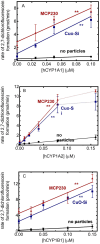Environmentally persistent free radicals lead to selective inhibition of CYP1 monooxygenase activities, and increased production of reactive oxygen species by reaction uncoupling
- PMID: 40556906
- PMCID: PMC12185410
- DOI: 10.3389/fpubh.2025.1531134
Environmentally persistent free radicals lead to selective inhibition of CYP1 monooxygenase activities, and increased production of reactive oxygen species by reaction uncoupling
Abstract
This study focuses on the effect of Environmentally Persistent Free Radicals (EPFRs) on the P450 enzymes of the CYP1 family. EPFRs are a component of particulate pollutants, that are stable in the environment, but can generate free radicals, leading to oxidative stress and subsequent toxicity of the respiratory, cardiovascular, and immune systems once they enter an organism. The results show differences in the ability of EPFRs to inhibit CYP1-dependent substrate metabolism, with CYP1B1 being inhibited to the greatest extent. There also were differences in the ability of EPFRs to disrupt the POR•CYP1 complex, with CYP1B1 being the only form where EPFRs disrupted POR•CYP1B1 complex formation. Despite the inhibition of substrate metabolism, each CYP1 enzyme, when reconstituted with NADPH-cytochrome P450 reductase (POR) was able to synergistically stimulate the generation of reactive oxygen (ROS) in the presence of particulate matter. Interestingly, both POR and the CYP1 enzymes were able to stimulate ROS generation, even when in partial reconstituted systems where only one of the proteins was present. However, when both POR and CYP1 were combined in a complete reconstituted system, ROS generation was synergistically stimulated.
Keywords: CYP1A1; CYP1A2; CYP1B1; cytochrome P450; environmentally persistent free radicals; enzyme inhibition; protein-protein interactions; reactive oxygen species.
Copyright © 2025 Connick, Stepter, Cawley, Eyer and Backes.
Conflict of interest statement
The authors declare that the research was conducted in the absence of any commercial or financial relationships that could be construed as a potential conflict of interest.
Figures




References
-
- Dellinger B, Pryor WA, Cueto R, Squadrito GL, Deutsch WA. The role of combustion-generated radicals in the toxicity of PM2.5. Proc Int Sump Combust. (2000) 28:2675–81. 10.1016/S0082-0784(00)80687-6 - DOI
-
- Lomnicki S, Dellinger B. A detailed mechanism of the surface-mediated formation of PCDD/F from the oxidation of 2-chlorophenol on CuO/silica surface. J Phys Chem. (2003) 107:4387–95. 10.1021/jp026045z - DOI
MeSH terms
Substances
LinkOut - more resources
Full Text Sources

